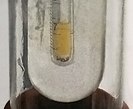Wikipedia:Today's featured article/September 23, 2014
Fluorine is an extremely reactive chemical element with atomic number 9 (pictured in liquid form at a cryogenic temperature). A highly toxic pale yellow gas at standard conditions, it was first described in 1529 as its principal source fluorite, a mineral added as a flux for smelting, and named after the Latin verb fluo meaning "flow". As the lightest halogen and most electronegative element, it is difficult to separate from its compounds, and several early experimenters died or were injured. The process employed for its modern production—low-temperature electrolysis—remains the same as that used by Henri Moissan in 1886 to achieve its first isolation. The high costs of refining fluorine gas lead most commercial uses, such as aluminium refining, insulation and refrigeration, to use its compounds; uranium enrichment is the free element's largest application. Fluorine is a part of some pharmaceuticals and appears as the fluoride ion in toothpaste, but has no known metabolic role in mammals; a few plants possess fluorine-containing poisons to deter herbivores. Fluorocarbon gases are usually potent greenhouse gases and organofluorine compounds persist in the environment. (Full article...)
Recently featured: System Shock – Gustav Holst – Great North of Scotland Railway

